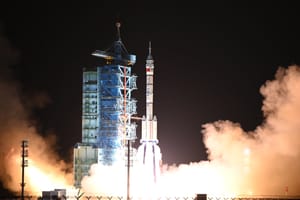
On July 16th a Long March 12 'simulator' was spotted being transported around the Wenchang Commercial Space Launch Site (文昌商业航天发射场), in China's southernmost province of Hainan. The simulator of the launch vehicle is believed to be for final 'fit' testing and rehearsals ahead of a maiden launch in August.
Full walk through of CZ-12. video via https://t.co/rTP5jh5lJ8 pic.twitter.com/8NGvWEtd6i
— Ace of Razgriz (@raz_liu) July 16, 2024
The Long March 12 simulator on the launch vehicle erector during transportation at the Wenchang Commercial Space Launch Site via raz_liu on X.
The Long March 12, which will be the first rocket to use the YF-100K engines, is a part of China's transition away from its older Long March launch vehicles, which are fueled by hypergolic propellants. The YF-100K is a more powerful variant of the YF-100 and will also be utilized on the in-development Long March 10 carrier rocket, which will enable crewed lunar missions.
According to Zeng Wenhua, a structural designer at the Shanghai Academy of Spaceflight Technology, will be used to launch satellite constellations, having said the following to China Daily in late February:
"The Long March 12 incorporates a number of new technologies and will feature high reliability and multiple functions. Its service will extensively improve our country's capability to send spacecraft to a sun-synchronous orbit and deploy multi-satellite networks in low orbits."
The Shanghai Academy of Spaceflight Technology's Long March 12 will be the second of three 'next generation' Long March carrier rockets to make its debut in 2024, after the inaugural flight of the Long March 6C in May and Long March 8A later this year. It will also be the first launch from China's fifth orbital launch site, the Wenchang Commercial Space Launch Site which is next door to the Wenchang Space Launch Site.
Wenchang Commercial Space Launch Site was declared capable of performing launches at the beginning of July after two years of construction. Final tests, inspections, and rehearsals have been performed across the launch site in recent months.
What is the Long March 12?
The Long March 12 is a two-stage launch vehicle manufactured by the Shanghai Academy of Spaceflight Technology. The launch vehicle is part of China's 'next generation' of carrier rockets and burns rocket-grade kerosene and liquid oxygen.
The believed payload capacity of the Long March 12 is approximately 12,000 kilograms to a low Earth orbit or 6,000 kilograms to a 700-kilometer sun-synchronus orbit.

Powering the first-stage are four YF-100K engines generating a combined thrust of 510 tons while burning liquid oxygen and rocket-grade kerosene. The second-stage is powered by two YF-115 engines generating 36 tons of thrust, also burning liquid oxygen and rocket-grade kerosene.
On the launchpad, the rocket stands a believed 59 meters in height, while having a first and second stage diameter of 3.8 meters. Fully fuelled the Long March 12 is believed to weigh 433,000 kilograms. The fairing of the Long March 12 is also believed to have options for either a 4.2 or 5.2-meter diameter, depending on the needs of the mission.
Why so many Long March rockets?
Introducing new rockets is an extensive process requiring overlap between old and new launch vehicles. New launch vehicles also have to demonstrate reliability and safety when carrying payloads.
China's state-owned launch vehicle providers and manufacturers are working towards the country's goal of phasing out its hypergolic fuelled launch vehicles. These new rockets are designed to burn rocket-grade kerosene and liquid oxygen instead of Dinitrogen Tetroxide and Unsymmetrical Dimethylhydrazine. The new rockets are the Long March 5, Long March 6, Long March 7, Long March 8, Long March 10, and Long March 12 series' of rockets.
But why transition from the older Long March vehicles? The older Long March launch vehicles use Dinitrogen Tetroxide and Unsymmetrical Dimethylhydrazine as propellants, both of which are hazardous if not handled properly. They were also designed in the 1970s and 1980s, thus manufacturing processes and design approaches have advanced significantly since then, particularly in China, which is now a world-class manufacturer.



